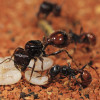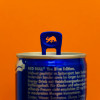US scientists have shown that a dab of make-up can make all the difference to a bird's lot in the dating stakes.
![Barn swallow (Hirundo rustica) (c) Malene Thyssen Barn swallow (Hirundo rustica)</p><p><div style="float: left;" id="block-inject-1" class="block-inject block-inject-1"><section id="block-block-25" class="block block-block clearfix"><div style="width: 160px; margin: 15px;"><script async src="//pagead2.googlesyndication.com/pagead/js/adsbygoogle.js"></script>
<ins class="adsbygoogle" style="display:inline-block;width:160px;height:600px" data-ad-client="ca-pub-1388850083651616" data-ad-slot="3413667069"></ins>
<script>
(adsbygoogle = window.adsbygoogle || []).push({});
</script>
</div></section></div><p>](/sites/default/files/media/800px-Landsvale.jpg) Working in New Jersey and writing in this month's current Biology, Princeton researcher Rebecca Safran and her colleagues trapped 63 male barn swallows at the start of the breeding season. The researchers weighed the birds and then used marker pens to add dark "highlights" to the breast feathers of half the males. The marked birds were then released back into the wild, re-captured a week later, re-weighed, and then given blood tests to look at their testosterone levels.
Working in New Jersey and writing in this month's current Biology, Princeton researcher Rebecca Safran and her colleagues trapped 63 male barn swallows at the start of the breeding season. The researchers weighed the birds and then used marker pens to add dark "highlights" to the breast feathers of half the males. The marked birds were then released back into the wild, re-captured a week later, re-weighed, and then given blood tests to look at their testosterone levels.
Amongst the marked birds testosterone levels rose by 36% in just 7 days, compared with controls males amongst whom the levels were 50% lower over the same period. The marked birds also lost some weight.
Both effects, the team speculate, could be down to the birds looking more attractive to females, which prefer darker mates, and hence mating more often. The enhanced colouration of the marked up birds might also alter their social pecking order, making them more dominant, but it may also be an esteem issue, suggests co-author Kevin McGraw.
"Other females might be looking at them as being a little more sexy, and the birds might be feeling better about themselves in response to that," he suggests. Safran likens it to a rich-man's swagger, "It's like 'the clothes make the man'. You're driving a Rolls Royce and people notice. And your physiology accommodates this."
Indeed, previous work has shown that mood can alter hormone levels. A study in 1998 detected a 20% hike in testosterone amongst sports fans when the team they were supporting won a game! But what makes this study stand out is that most of the time it's thought that hormones are what drive changes to behaviour and appearance; these results reveal that it's more of a two-way street. Where it leads though, still needs to be mapped out.










Comments
Add a comment